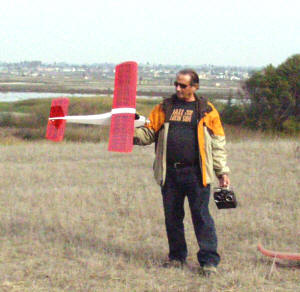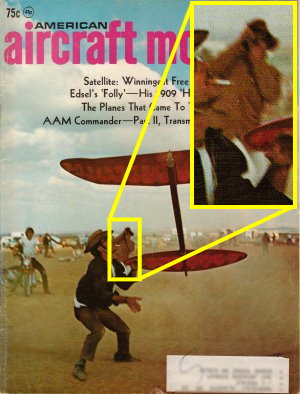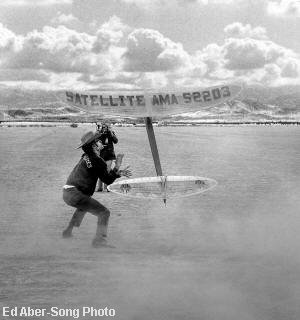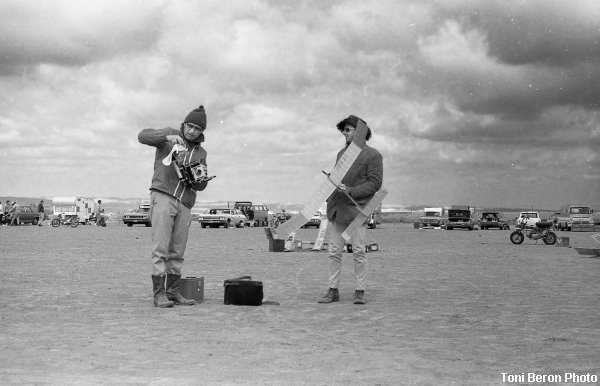|
One
of my primary motivations for making articles and other items from
vintage editions of American Modeler and American Aircraft Modeler
magazines available online is so that people who were involved in
aeromodeling decades ago might perchance do a search and happily
find either themselves, a friend, or a relative mentioned. Since
starting
AirplanesAndRockets.com
a couple years ago, a few people have written to thank me for the
effort. I'm glad to do it. I also respond to requests to scan and
post any article if I happen to have the necessary copy of the magazine.
By far the coolest contact I have had so far was this one just
received from Ed Aber-Song, who, while reading the article on Bill
Hunter's
Satellite 1000 free flight model in the May 1972 edition of
AAM, was surprised to see himself in the background of the Cover
Photo! It was from the November 1971 free flight championships in
Taft, California.

None other than Ed Amber-Song in November 2012 with his newly-maidened
e-powered Super Sniffer. He also recently completed a high-resolution,
full-size version of the Satellite 1000 plans in PDF file format.
(Added 12/9/2012)
Says Ed, "I was browsing your excellent website and while
looking at the Bob and Bill Hunter Satellite plans, noticed that
I am in the Cover Photo of the May 1972 American Aircraft Modeler
magazine. I was taking a photo of Bill Hunter at exactly the
same moment as the photographer who shot the Cover Photo. I'm wearing
the funky hat standing on the other side as Bill launched his airplane. I
had no idea I was in the Cover Photo! The photo I shot at the exact
same moment is attached. How strange that these two photos came
together so many years later."Upon requesting permission
to post his photo and story, Ed responded, "Yes, please feel free
to post the image on your website along with my name, Ed Aber (AMA
179), member of Cloud Dusters Model Airplane Club. At the time
I was flying competition free flight and friends with Bob and Billy
Hunter of the San Valeers Model Airplane Club in SoCal. Later
the same year I set a C Gas National Record and shortly afterward
embarked upon a career as a professional photographer and journalist."
Did you notice AMA 179?!!!
See the e-mail that
Mike Schwartz sent regarding the
Satellite
series.
 |

<click for larger version> |
| Here is the Cover Photo from the May 1972 American Aircraft
Modeler. Ed Aber is the guy in the background taking the
picture from the other side of Bill Hunter's Satellite 1000.
The photographer for this Cover Photo was either Paul or
Mary Ortman. |
At virtually the same moment in time, here is Ed's photo
of Bill Hunter and his Satellite 1000, showing the AAM cover
photographer in the background. INCREDIBLE!!! |
More from Ed: "Here's photo of the cover photographer at
the contest taking a photo of me."

This is Ed (on right) with his model,
as taken by photographer Toni Beron. Dateline: 1971 Taft Free
Flight Championships Many thanks to Ed for making this gem of a coincidence available.
OK, I received another very interesting comment on this
cover from Mr. Mike Schwartz:
(original e-mails have
been reformatted) January 9, 2013 "Hi Kirt:
My name is Mike Schwartz and I flew with Bob and Bill Bunter beginning
in 1958. I am in the process of writing the history of the Satellite
design for the 2013 NFFS Symposium. There are some statements
made concerning the May 72 Satellite 1000 article and the cover
shot that need clarification. The plane on the cover that Bill is
flying is in fact a Satellite 1300 powered by a ST. 65. Because
of the Satellite 1000 article and plans everyone all these years
have assumed the cover airplane to be the 1000 size. In 1970
when the series 70 satellite was designed , the first 3 built were
in fact 1300's powered by ST.65 engines. Bob, Bill and I built the
first 3 which are the only ones that had the planked wing and stab
leading edges. If you look at the cover shot you can see the
planked leading edges. As a matter of interest all 3 1300's were
built in 7 straight days of building from cutting out all the parts
to the final assembly and ready to fly. All of this work could only
be done thru the use of " hot stuff" glue. The location of
the shot was not Taft but a flying site just off Basic School Road
which is approximately 6 miles from the current Taft flying site. We
used to fly at Gardner Field which is at the end of Basic School
Road just as you turn left to head towards Taft.
Gardner Field was a World War 2 basic training field
for the Army Air Forces. All the buildings had been removed but
the foundations remained which were a hazard to the models. In 1970
all the local clubs got together to start a contest that became
the F.F. champs. A new site was found that was on the west side
of Basic School Road just south of the California aqueduct before
you got to Gardner Field and the first 2 FF champs were held
there. In 1972 the FF champs moved to the current Taft site. If
you
Google Taft, California on their map site you can see the area
in question. We would take I-5 north from L.A. and drive to the
Maricopa Highway (166) exit and head west until we reached Basic
School Road, where you turned right to head towards the flying
site. If you wanted to go to Taft you would make a left on Cadet
Road where Basic School Road ended and head east to Gardner Field
Road where you turned right to Taft. As you can see all the roads
in that area were named related to Gardner Field. Ed Aber's
photo of Bill launching his plane was taken towards the south
with Maricopa Highway in the far background. Likewise the AAM photographer
was looking north. If you look at the terrain in the
May 72 issue you can
then compare the terrain in the April 73 issue in
The Giants of Free
Flight [Mike is in that article, KRB]
article in which the photos were taken at Taft and then you
can see the difference.
Concerning
the satellite 1000 plans, the original plans were drawn on vellum
paper and then 3 copies were printed. 1 copy was cut up to
make the templates needed and the rest of that plan was used
by Bob and Bill to make the 2 prototypes. Bob retained 1 copy for
his records and I got the 3rd. I still have my original copy. The
vellum original was then revised for the May 72 satellite
article and plans. I also have a copy of that plan. The vellum original
was revised a 2nd time for the Satellite City Pro kit plans. I also
have that plan. In 1957 when the first Satellite was designed
the first one built was a 1300 also. This was followed by 3 of the 800
size models. I have one of the 800's which is the oldest existing
Satellite. If you want to read the rest of the Satellite
history you will have to get a copy of the 2013 NFFS Symposium.
If you have any questions please e-mail me. Regards, Mike"
...and a follow-up on January 12, 2013 "Kirt: I need
to add one item to my list of 1957 Satellite designs. When I e-mailed
you about the various Satellite sizes I was thinking about the ones
of which actual plans were drawn. I forgot that in 1959 Bill Hunter
built a 1000 sq. in. size. He built the plane using the 800 size
plan which he used to build it around the outside of the drawings.
This was a one-off size which was built to compete at the 59 Nats
where he won the Jr. National Championship. It was built because
of the new heavy weight rules that were in effect then. The plane
had a Johnson .29 for class B. The plane had a fiberglass fishing
pole blank for a fuselage with a 1/2" plywood pylon to bring it
up to the weight rule. In my NFFS Symposium article I am going to
write about the use and history of this method of fuselage construction.
This plane and all the other early Satellites that Bob and Bill
had were lost on the way to the 60 Nats when the top came off the
roof top carrier at 65 mph just outside Blythe, California. The
wings and stabs flew out and were destroyed when following trucks
ran over them. Regards: Mike Schwartz "
Posted May 1, 2011
|


